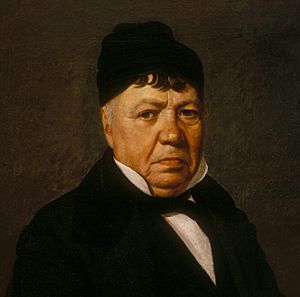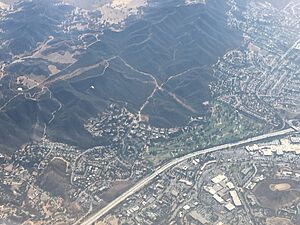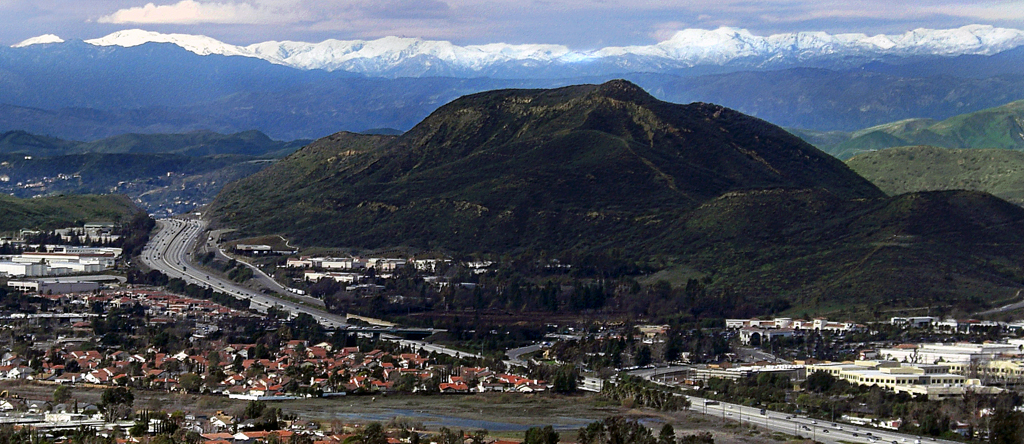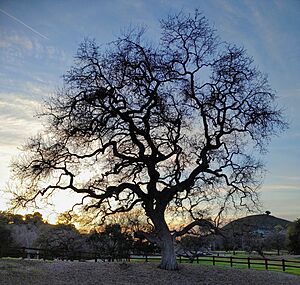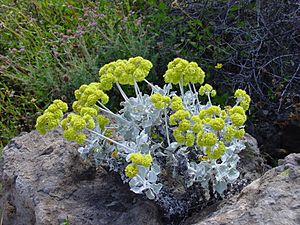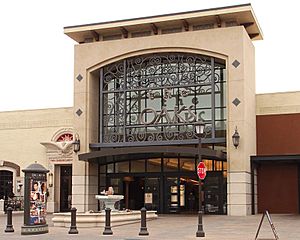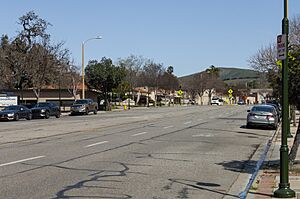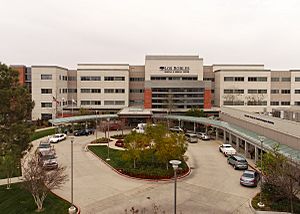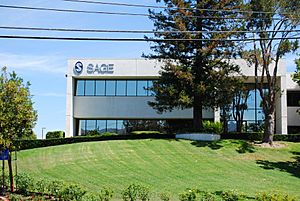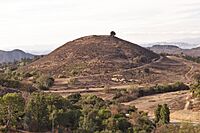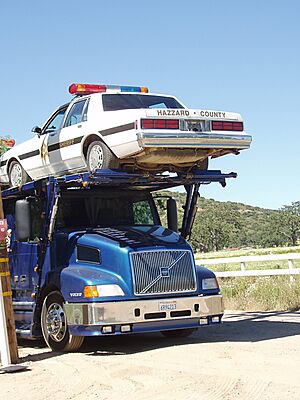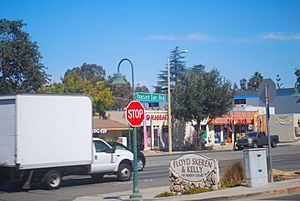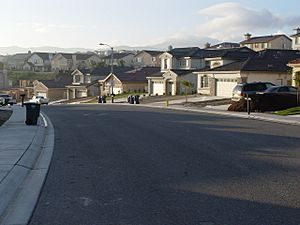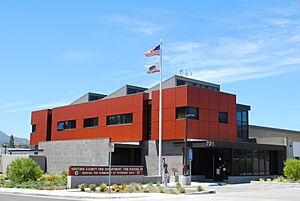Thousand Oaks, California facts for kids
Quick facts for kids
Thousand Oaks
|
|||
|---|---|---|---|
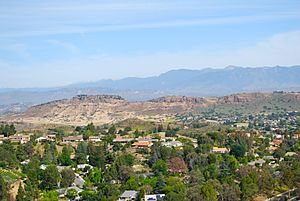
Mount Clef Ridge as seen from Tarantula Hill, Thousand Oaks
|
|||
|
|||

Location in Ventura County, California
|
|||
| Country | United States | ||
| State | California | ||
| County | Ventura | ||
| Region | Conejo Valley | ||
| Incorporated | October 7, 1964 | ||
| Government | |||
| • Type | Council/Manager | ||
| Area | |||
| • City | 55.41 sq mi (143.51 km2) | ||
| • Land | 55.26 sq mi (143.13 km2) | ||
| • Water | 0.14 sq mi (0.38 km2) 0.27% | ||
| Elevation | 886 ft (270 m) | ||
| Population
(2020)
|
|||
| • City | 126,966 | ||
| • Rank | 2nd in Ventura County 49th in California |
||
| • Density | 2,291.39/sq mi (884.72/km2) | ||
| • Urban
(Thousand Oaks, CA)
|
213,986 (US: 181st) | ||
| • Urban density | 2,668.3/sq mi (1,030.2/km2) | ||
| • Metro | 843,843 (US: 71st) | ||
| Time zone | UTC−8 (Pacific) | ||
| • Summer (DST) | UTC−7 (PDT) | ||
| ZIP Codes |
91320, 91359–91362
|
||
| Area code(s) | 805/820 | ||
| FIPS code | 06-78582 | ||
| GNIS feature IDs | 1661567, 2412065 | ||
Thousand Oaks is a city in Ventura County, California. It is the second-largest city in the county. Thousand Oaks is about 15 miles (24 km) from Los Angeles. The city gets its name from the many oak trees in the area.
Thousand Oaks is the main city in the Conejo Valley. It became an official city in 1964. Since then, it has grown quite a bit. Parts of Westlake and most of Newbury Park became part of Thousand Oaks in the 1960s and 1970s. The city's eastern edge touches Los Angeles County and the city of Westlake Village. In 2020, about 126,966 people lived in Thousand Oaks.
Contents
History of Thousand Oaks
How Thousand Oaks Got Its Name
In the 1870s, the area was sometimes called Conejo Mountain Valley. In the 1920s, when only about 100 people lived here, they decided to pick a new name. A contest was held, and a 14-year-old named Bobby Harrington suggested "Thousand Oaks." This name won because the valley has tens of thousands of oak trees, maybe even 50,000 to 60,000!
When the city officially formed in 1964, a company called Janss Corporation suggested "Conejo City." But many residents signed a petition to put "Thousand Oaks" on the ballot. In the election on September 29, 1964, a huge number of people, 87% of the 19,000 residents, voted for Thousand Oaks.
Early People and Times

The Chumash people were the first to live here, starting over 10,000 years ago. They had two main villages: Sap'wi ("House of the Deer") and Satwiwa ("The Bluffs"). Today, Sap'wi is near the Chumash Indian Museum, which has ancient 2,000-year-old rock paintings called pictographs. Satwiwa is now home to the Native American Indian Culture Center, located at the base of Mount Boney, a sacred mountain for the Chumash.
Smaller Chumash villages were also located where Wildwood Elementary School and Lang Ranch are today. The area around Wildwood Regional Park has many ancient Chumash artifacts like stone tools, shell beads, and arrowheads.
Each village had a chief or several leaders who met to discuss important matters. A group of elders helped guide village life. Most villages had a cemetery, a place for games, a sweat house, and areas for ceremonies. You can see local Chumash artifacts at the Satwiwa Native American Indian Culture Center and the Chumash Indian Museum.
The first written history of the region dates back to 1542. That's when Spanish explorer Juan Rodriguez Cabrillo landed at Point Mugu. He claimed the land for Spain. Later, the Chumash and Spanish fought over land near Triunfo Creek.
Spanish and Mexican Periods
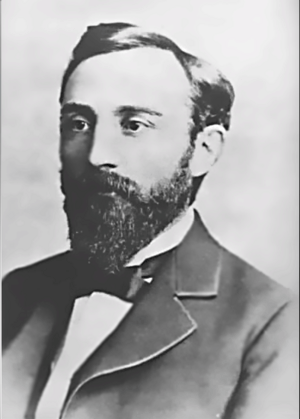
From 1804 to 1848, Thousand Oaks was part of Alta California, which was a Spanish territory. The Spanish named the area Conejo Valley, meaning "Valley of Rabbits." In 1803, Jose Polanco and Ignacio Rodriguez were given the land grant for El Rancho Conejo, which covered over 48,000 acres.
In 1822, Alta California became part of Mexico. Captain José de la Guerra y Noriega claimed Conejo Valley as part of a Mexican land grant. It remained Mexican territory until California became a republic in 1846, and then part of the U.S. in 1850. The valley was then known as Rancho El Conejo. The de la Guerra family sold much of this land in the 1860s and 1870s.
By the 1870s, two men owned most of Conejo Valley: John Edwards and Howard Mills. Edwards owned much of what is now Thousand Oaks and Newbury Park. Mills owned most of Westlake Village. Egbert Starr Newbury bought 2,259 acres in 1874, stretching into today's Newbury Park. He opened the valley's first post office in 1875. By 1877, 126 people lived in Conejo Valley.
In the late 1800s, Newbury Park was a stop on the stagecoach route between Los Angeles and Santa Barbara. The Stagecoach Inn was built in 1876. It is now a museum and a California Historical Landmark.
Norwegian Colony
Thousand Oaks was home to a Norwegian community around the late 1800s and early 1900s. It was called Norwegian Colony. This community was located where California Lutheran University is today. It covered over 650 acres.
Many local places are named after Norwegian immigrants, like the Olsen and Pedersen families. The first Norwegians came from a village called Stranda in Norway. They helped build the Norwegian Grade in 1911, a mile-long road connecting Thousand Oaks to Santa Rosa Valley.
However, the Norwegian Colony did not last long. There were no doctors or hospitals nearby. Many settlers, including seven of the Olsen family's ten children, died in a diphtheria outbreak in 1901.
20th Century Growth
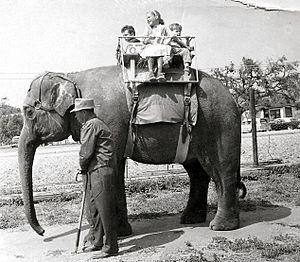

In the early 1900s, Newbury Park was more developed than Thousand Oaks. The Janss family bought 10,000 acres here. They planned to build a "total community." But development was slow, especially during the Great Depression in the 1930s. Besides farming, the movie industry became important in the 1920s and 1930s.
Between 1950 and 1970, the Conejo Valley grew very fast. The population jumped from 3,000 to 30,000 residents. By 1989, Thousand Oaks had over 103,000 people. Many high-tech companies moved to Thousand Oaks in the 1960s and 1970s.
Jungleland USA helped make Thousand Oaks famous in the 1920s. It attracted Hollywood producers to the city. Hundreds of movies have been filmed in Thousand Oaks. Early films included The Birth of a Nation (1915) at Jungleland and Roaring Ranch (1930) at the Stagecoach Inn. Thousand Oaks Boulevard was even in the movie It Happened One Night (1934). Elvis Presley and John Wayne filmed many westerns in Wildwood Regional Park.
Many celebrities moved to the Conejo Valley, including Joel McCrea, Dean Martin, Bob Hope, and Roy Rogers. By 1988, Thousand Oaks had 11,000 businesses. The world's largest biotechnology company, Amgen, started in Newbury Park in 1980.
Jungleland USA Zoo

Louis Goebel started "Goebel's Lion Farm" in 1926. It was located where the Thousand Oaks Civic Arts Plaza is today. He started with lions and dogs, then added giraffes, camels, hippos, and other exotic animals.
Many animals from the park were used in movies and TV shows, like the Tarzan films and Doctor Doolittle (1967). The park became very popular in the 1940s and 1950s. It offered animal shows, elephant rides, and safari tram tours.
In 1956, the park changed its name to Jungleland USA. But it closed in 1969 because of competition from places like Disneyland. The park's 1,800 animals were sold at an auction.
Becoming a City
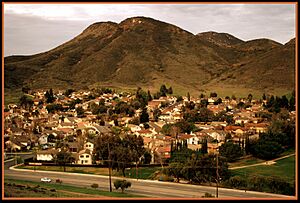
Thousand Oaks officially became a city on October 7, 1964. Voters approved the idea and chose the name on September 29, 1964.
Some areas, like Newbury Park, tried to form their own cities but didn't succeed. Most of Newbury Park later joined Thousand Oaks. Only Casa Conejo and Ventu Park in Newbury Park are not part of Thousand Oaks today. Lynn Ranch also chose to stay outside the city.
Two-thirds of the planned community of Westlake joined Thousand Oaks in 1968 and 1972. North Ranch also became part of the city in 1973.
Modern Times in Thousand Oaks
Thousand Oaks is now encouraging new types of buildings downtown. These buildings will have shops on the bottom and homes above. The city is already mostly built up, so it's focusing on smart growth instead of spreading out more.
The Moorpark Freeway (Highway 23) became very busy in the late 1990s. A big project to widen the freeway started in 2008.
In 2016, California Lutheran University and the NFL Rams football team agreed that the Rams would train at the university for two years. The Rams built practice fields and other buildings there.
On November 7, 2018, a tragic shooting happened at the Borderline Bar and Grill. Days later, the Woolsey Fire threatened the community. This fire burned many homes and nearly 100,000 acres of land.
Geography and Nature


Thousand Oaks is in the Conejo Valley in southeastern Ventura County. It's about halfway between Los Angeles and Santa Barbara. The Pacific Ocean is about 12 miles (19 km) to the west. The city covers about 55 square miles (143 km2).
A large part of the city, 34%, is protected open space. This includes parts of the Santa Monica Mountains National Recreation Area. Thousand Oaks is part of the Greater Los Angeles Area. The closest coastal city is Malibu, which can be reached through mountain roads. The Conejo Valley is surrounded by mountains: the Santa Monica Mountains to the south, Conejo Mountains to the west and north, and Simi Hills to the northeast.
Newbury Park makes up about 40% of the city's total land area. Most of Thousand Oaks is land, with a very small amount of water.
Even though Thousand Oaks has several shopping centers, like Janss Marketplace and The Oaks mall, many people live in quiet suburban neighborhoods away from the main commercial areas. This design helps keep heavy traffic off residential streets.
Landscape and Hills
The city's landscape has many hills, mountains, open views, and native oak forests. It is known for its 50,000 to 60,000 oak trees and rolling green hills.
The northern parts have mountains like the Simi Hills, Conejo Mountains, and Mount Clef Ridge. Narrow canyons, like Hill Canyon, cut through these mountains. Conejo Mountain and Conejo Grade are in western Newbury Park. The southern parts of Thousand Oaks have Russell Valley, Hidden Valley, and the steep Santa Monica Mountains. The highest point is Simi Peak at 2,403 feet (732 m). The main river is Conejo Creek.
Wetlands in the area include Lake Eleanor, Paradise Falls in Wildwood Regional Park, Twin Ponds, and the 7-acre Hill Canyon Wetlands.
Wildlife in Thousand Oaks
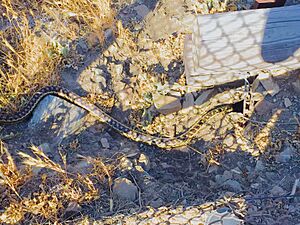
Thousand Oaks is home to many animals. You might see mountain lions, bobcats, coyotes, bears, grey foxes, and mule deer. Smaller animals include skunks, California raccoons, Virginia opossums, and different types of rabbits, squirrels, and mice. Mountain lions are sometimes seen in the city's larger open spaces. Hikers are advised not to hike alone and to keep children close.
Some amphibians and reptiles found here are various lizards, turtles, and many kinds of snakes, including southern Pacific rattlesnakes and California kingsnakes. Amphibians include ensatinas, slender salamanders, and different types of frogs and toads.
Birds of Thousand Oaks
Over 170 types of birds have been seen in Thousand Oaks. Common birds include the house sparrow, house finch, and California quail. The Conejo Valley has many raptors, which are birds of prey. Some raptors found here include the golden eagle, red-tailed hawk, barn owl, and American kestrel.
Plants of Thousand Oaks
Thousand Oaks has over 100 plant species. There are four endangered plant species: Conejo buckwheat, Santa Monica dudleya, Conejo dudleya, and Lyon's pentachaeta. The city has between 50,000 and 60,000 oak trees. Four types of oak trees are native to Thousand Oaks: valley oak, coast live oak, scrub oak, and Palmer's oak. The largest oak tree in the city is at the Chumash Indian Museum. Thousand Oaks is known as a "Tree City USA."
Some plant species are found nowhere else on Earth. The wildflower Conejo buckwheat grows only in Wildwood Regional Park and near the Conejo Grade. It grows on volcanic rock and has yellow flowers. It is in danger of disappearing. Another unique plant, Conejo dudleya, is found throughout the valley.
A special tree is the 300-year-old "Historic Sycamore Tree." It is a landmark at the Stagecoach Inn in Newbury Park.
You can see native plants at several gardens in the city. These include Gardens of the World, Conejo Valley Botanic Garden, and the gardens at the Chumash Indian Museum.
Climate in Thousand Oaks
| Weather chart for Thousand Oaks, California | |||||||||||||||||||||||||||||||||||||||||||||||
|---|---|---|---|---|---|---|---|---|---|---|---|---|---|---|---|---|---|---|---|---|---|---|---|---|---|---|---|---|---|---|---|---|---|---|---|---|---|---|---|---|---|---|---|---|---|---|---|
| J | F | M | A | M | J | J | A | S | O | N | D | ||||||||||||||||||||||||||||||||||||
|
4.2
67
36
|
4.2
68
38
|
3
70
40
|
1.1
74
43
|
0.3
77
47
|
0.1
83
50
|
0
91
55
|
0
91
54
|
0.2
89
52
|
0.4
82
47
|
1.6
75
40
|
2.3
68
36
|
||||||||||||||||||||||||||||||||||||
| temperatures in °F precipitation totals in inches |
|||||||||||||||||||||||||||||||||||||||||||||||
|
Metric conversion
|
|||||||||||||||||||||||||||||||||||||||||||||||
Thousand Oaks has a warm-summer Mediterranean climate. This means it has mild, wet winters and hot, dry summers. The hillsides have chaparral plants and grasses, along with many oak trees. The city's elevation ranges from about 500 to 900 feet. It often has slightly cooler temperatures than nearby areas because of cool air from the ocean. Snow rarely falls, but it did snow on Boney Mountain in 2006 and 2008.
Summer temperatures are usually between 70 and 80 degrees Fahrenheit (21-27 Celsius). Winter temperatures rarely drop below 60-65 degrees Fahrenheit (15-18 Celsius). Newbury Park usually has cooler summers than central Thousand Oaks.
| Climate data for Thousand Oaks, California | |||||||||||||
|---|---|---|---|---|---|---|---|---|---|---|---|---|---|
| Month | Jan | Feb | Mar | Apr | May | Jun | Jul | Aug | Sep | Oct | Nov | Dec | Year |
| Record high °F (°C) | 94 (34) |
92 (33) |
98 (37) |
104 (40) |
105 (41) |
119 (48) |
117 (47) |
115 (46) |
119 (48) |
108 (42) |
100 (38) |
94 (34) |
119 (48) |
| Mean daily maximum °F (°C) | 66.6 (19.2) |
67.9 (19.9) |
70.2 (21.2) |
73.9 (23.3) |
77.4 (25.2) |
83.4 (28.6) |
90.9 (32.7) |
91.4 (33.0) |
88.7 (31.5) |
82.1 (27.8) |
74.8 (23.8) |
67.9 (19.9) |
77.9 (25.5) |
| Mean daily minimum °F (°C) | 35.9 (2.2) |
38.1 (3.4) |
40.0 (4.4) |
43.1 (6.2) |
46.9 (8.3) |
50.2 (10.1) |
54.5 (12.5) |
54.2 (12.3) |
52.1 (11.2) |
46.7 (8.2) |
40.3 (4.6) |
36.4 (2.4) |
44.9 (7.2) |
| Record low °F (°C) | 13 (−11) |
22 (−6) |
25 (−4) |
27 (−3) |
31 (−1) |
34 (1) |
40 (4) |
40 (4) |
37 (3) |
27 (−3) |
23 (−5) |
16 (−9) |
13 (−11) |
| Average precipitation inches (mm) | 4.18 (106) |
4.15 (105) |
2.99 (76) |
1.07 (27) |
0.30 (7.6) |
0.05 (1.3) |
0.03 (0.76) |
0.04 (1.0) |
0.21 (5.3) |
0.40 (10) |
1.59 (40) |
2.33 (59) |
17.35 (441) |
| Average snowfall inches (cm) | 0.1 (0.25) |
0 (0) |
0 (0) |
0 (0) |
0 (0) |
0 (0) |
0 (0) |
0 (0) |
0 (0) |
0 (0) |
0 (0) |
0 (0) |
0.1 (0.25) |
| Source: all-time record high: | |||||||||||||
People of Thousand Oaks
| Historical population | |||
|---|---|---|---|
| Census | Pop. | %± | |
| 1950 | 1,243 | — | |
| 1960 | 2,934 | 136.0% | |
| 1970 | 35,873 | 1,122.7% | |
| 1980 | 77,072 | 114.8% | |
| 1990 | 104,352 | 35.4% | |
| 2000 | 117,005 | 12.1% | |
| 2010 | 126,683 | 8.3% | |
| 2020 | 126,966 | 0.2% | |
| 2023 (est.) | 122,967 | −2.9% | |
| U.S. Decennial Census | |||
| Ancestry in Thousand Oaks | ||||
|---|---|---|---|---|
| Origin | percent | |||
| German American | 15.8% | |||
| Mexican American | 12.9% | |||
| English American | 11.7% | |||
| Irish American | 10.7% | |||
| Italian American | 7.2% | |||
| Russian American | 3.4% | |||
| Chinese American | 3.3% | |||
| French American | 3.2% | |||
| Polish American | 3.2% | |||
| Scottish American | 2.7% | |||
| Indian American | 2.7% | |||
| Norwegian American | 2.2% | |||
| Swedish American | 2% | |||
| Dutch American | 1.5% | |||
| African American | 1.3% | |||
| Other | 18.9% | |||
Thousand Oaks was first built for working-class families in the 1950s. Today, it is a city with many highly educated residents.
In 2020, the population of Thousand Oaks was 126,966. Most residents were White (62.90%), followed by Hispanic or Latino (19.90%), and Asian (9.86%).
In 2010, there were 45,836 households. About 36% of them had children under 18. The average household had 2.73 people. The median age in the city was 41.5 years. Most people (73%) lived in homes they owned. The median household income was $121,088.
Economy and Jobs
Farming was the main industry in Thousand Oaks until the 1950s. Then, many high-tech companies moved to Newbury Park in the 1960s. Today, Thousand Oaks is a center for biotechnology, with companies like Amgen.
The city's economy includes biotechnology, electronics, cars, aerospace, healthcare, and finance. Besides Amgen, other companies with headquarters here are Teledyne Technologies, SAGE Publishing, and Skyworks Solutions. Large companies like Bank of America and Volkswagen also have offices here. Other big employers include Los Robles Hospital & Medical Center, Conejo Valley Unified School District, and California Lutheran University.
J.D. Power and Associates, a company known for its customer satisfaction surveys, is also based in Thousand Oaks. Many residents work close to home, and over 40% work as executives or business professionals.
Top Employers
Here are the top employers in Thousand Oaks:
| No. | Employer | No. of employees |
|---|---|---|
| 1 | Amgen Inc. | 5,000 |
| 2 | Conejo Valley Unified School District | 3,010 |
| 3 | Los Robles Hospital & Medical Center | 1,800 |
| 4 | California Lutheran University | 1,316 |
| 5 | Skyworks Solutions Inc | 612 |
| 6 | City of Thousand Oaks | 530 |
| 7 | Takeda Pharmaceutical Company | 526 |
| 8 | Sports Academy | 400 |
| 9 | PennyMac Loan Services | 376 |
| 10 | SAGE Publishing | 336 |
Arts and Culture
The Conejo Valley Art Museum shows art from different artists. The Chumash Indian Museum has displays of Chumash artifacts and a rebuilt Chumash village. The historic 1876 Stagecoach Inn in Newbury Park is now a museum and a California Historical Landmark. Also in Newbury Park is the Satwiwa Native American Indian Culture Center, a museum at the base of Mount Boney. The American Radio Archive at Grant R. Brimhall Library has one of the largest collections about radio history in the world.
The Thousand Oaks Civic Arts Plaza has two theaters: the Fred Kavli Theatre and the Ray Scherr Forum Theatre. Many famous performers have appeared here, including Willie Nelson and Liza Minnelli.
The Conejo Players Theatre has been active since 1958. The Hillcrest Center for the Arts hosts various theater groups and summer concerts. Art galleries include the Fred Kavli Theatre Gallery and the Thousand Oaks Community Art Gallery.
The annual Scandinavian Festival ("Scan Fest") happens every April at California Lutheran University. It celebrates the culture of Nordic countries like Norway, Sweden, and Denmark with food, music, and dance. The first festival was held in 1974.
Conejo Valley Days is a yearly spring festival with a carnival. The OakHeart Country Music Festival is an outdoor concert held in June. It features popular country music artists.
In 2018, Thousand Oaks hosted its first LGBTQ+ event. It celebrated the LGBTQ+ community with talent, services, and art.
Places to Visit

- American Radio Archive: A museum about the history of radio.
- California Lutheran University: A university with beautiful grounds.
- Chumash Indian Museum: A museum with a replica of a Chumash village.
- Conejo Valley Art Museum: An art museum at Janss Marketplace.
- Conejo Valley Botanic Garden: A 33-acre garden with many plants.
- Conejo Valley High: The oldest public landmark in Conejo Valley.
- Dawn's Peak: Also known as Tarantula Hill, the highest point in Thousand Oaks.
- Gardens of the World: A botanical garden with plants from different countries.
- Joel McCrea Ranch: A historic ranch listed on the U.S. National Register of Historic Places.
- Oak Creek Canyon Whole Access Interpretive Trail: A trail with signs describing local plants and animals.
- Satwiwa Culture Center: A Chumash museum at the base of Mount Boney.
- Sherwood Country Club: A golf course that hosted the Tiger Woods' World Challenge.
- Stagecoach Inn: A historic hotel in Newbury Park.
- The Oaks Shopping Center: The largest shopping mall in Ventura County.
- Thousand Oaks Civic Arts Plaza: Home to City Hall and two theaters.
- Thousand Oaks Community Gallery: An art gallery near Newbury Park Library.
- Thousand Oaks Library: The largest library in Ventura County.
- Wildwood Regional Park: A large 1,765-acre regional park.
Sports in Thousand Oaks
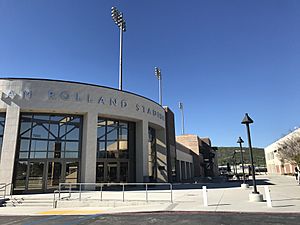
The Los Angeles Lightning is a local basketball team based at California Lutheran University (CLU). CLU has also been a summer training camp for NFL teams like the Los Angeles Rams and Dallas Cowboys. The U.S. Olympic Men's Water Polo teams trained at CLU in 2008 and 2012.
Many youth sports programs are active here, including soccer, basketball, wrestling, football, baseball, softball, swimming, ice hockey, lacrosse, rugby, and field hockey.
The Ventura County Fusion, a minor-league soccer team, has played home games at Newbury Park High School. The Conejo Oaks semi-pro baseball team plays in Thousand Oaks. The Ventura County Outlaws is a rugby union team based here.
The city is home to the Sherwood Country Club, a golf course designed by Jack Nicklaus. The Chevron World Challenge golf tournament, hosted by Tiger Woods, was held here from 2000 to 2013.
Professional Football
For 27 years, California Lutheran University hosted the training camp for the Dallas Cowboys. The last camp was in 1989. The Los Angeles Rams also used CLU for their temporary headquarters and practice facilities.
Baseball Success
Thousand Oaks has a strong history in Little League baseball.
- In 1994, a Thousand Oaks Junior League team won the World Championship.
- In 1996, a Senior Division team won a National Championship.
- In 1998, a Big League Division team won a World Championship.
- In 2006, a Big League team won the World Championship again.
- The Thousand Oaks Big League team was also a World Series runner-up in 2003 and 2005.
- In 2009, they won the United States Championship.
- In 2004, the Conejo Valley East team won the Little League National Championship.
Parks and Recreation
Thousand Oaks is known for protecting its open spaces. About one-third of the city has been permanently saved from development. The city has about 150 miles (240 km) of trails for hiking, biking, and horseback riding. In 1996, the city received the Trail Town USA Hall of Fame Award for its trail system. Thousand Oaks is also recognized as a "Tree City USA."
Education
The Conejo Valley Unified School District serves Thousand Oaks. Public schools in the city have high academic scores. The district includes many elementary schools, three middle schools (Colina, Redwood, and Los Cerritos), and three high schools (Thousand Oaks, Newbury Park, and Westlake).
The Thousand Oaks Library system is one of the best public libraries in California. It includes the Grant R. Brimhall Library and the Newbury Park Branch Library. In 2006, a 22,000-square-foot (2,000 m2) children's library was added to the main building. Both libraries offer free wireless internet.
California Lutheran University has been ranked among the "Top 25 Universities in the Western United States" by U.S. News & World Report for over ten years. In 2018, it was ranked 14th.
Media
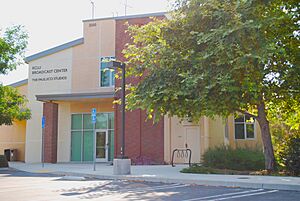
The Acorn is the main newspaper for Thousand Oaks, Newbury Park, and Westlake Village. The Ventura County Star covers all of Ventura County.
Thousand Oaks is home to several radio station transmitters, including KCLU-FM, an NPR station based at California Lutheran University. Thousand Oaks TV is a 24-hour cable TV station started by the city in 1987.
Movies and TV Filming
Many movies and TV shows have been filmed in Thousand Oaks because of its good weather and location. For example, Thousand Oaks Boulevard was seen in the Oscar-winning film It Happened One Night (1934). Elvis Presley and John Wayne filmed movies in Wildwood Regional Park.
Greenfield Ranch has appeared as a zoo in We Bought a Zoo (2011). It has also been featured in TV series like True Blood and Criminal Minds. A home in Hidden Valley was used in the movie It's Complicated (2009) starring Meryl Streep.
Other films shot here include Memoirs of a Geisha (2005) and The Adventures of Robin Hood (1938).
City Services
Transportation
Roads
Thousand Oaks is in the center of the Conejo Valley. U.S. Route 101 (the Ventura Freeway) runs through the city, connecting it to Los Angeles and Ventura. State Route 23 (the Moorpark Freeway) connects to Highway 101 and goes north towards Moorpark.
Public Transport
Thousand Oaks Transit provides public transportation with shuttles and buses. These buses serve Thousand Oaks and some nearby communities.
A regional transportation center offers bus and shuttle lines to Los Angeles, Oxnard, Ventura, and Santa Barbara. Train services are available at stations in Moorpark and Camarillo.
Airports
For air travel, people mainly use Los Angeles International Airport or Bob Hope Airport in Burbank. Thousand Oaks offers public transportation to both airports.
There used to be two airports in Thousand Oaks. The first, Conejo Valley Airport, was opened by the Janss Corporation in the 1940s. It was often used in movies. This airport closed by 1962 and is now the Los Robles Greens Golf Course. A second airport, Rancho Conejo Airport, opened in 1960. It was considered a top executive airport and was used in the film It's a Mad, Mad, Mad, Mad, World. This airport closed by 1966.
Water Supply
The city gets its drinking water from the state water system.
Fire Department
The Ventura County Fire Department provides fire protection and emergency medical services for Thousand Oaks. Before the 1930s, local ranchers fought fires. In 1932, Louis Goebel, who owned Goebel's Lion Farm, built the first fire station for the city.
Over the years, more fire stations were built. Fire personnel in Thousand Oaks work closely with firefighters in Los Angeles County.
Law Enforcement
The Thousand Oaks Police Department and Ventura County Sheriff's Office provide police services. The Thousand Oaks Police Department started on July 1, 1965, and has worked with the sheriff's department since then.
The first police station was a small room at a fire station. Later, a house was rented for the police. In 1969, a professional sheriff's station was built, and a more modern one replaced it in 1988.
Honoring an Officer
A part of the Ventura Freeway that goes through Thousand Oaks is named after Ventura County Sheriff Sergeant Ron Helus. He was killed while responding to a mass shooting event in November 2018.
Famous People from Thousand Oaks
- Sparky Anderson, baseball manager
- Eve Arden, actress
- Frankie Avalon, singer and actor
- Amanda Bynes, actress
- Belinda Carlisle, singer
- Richard Carpenter, musician
- Ellen DeGeneres, television host
- Bob Denver, actor
- Aaron Donald, football player
- John Fogerty, musician
- Jared Goff, football player
- Wayne Gretzky, ice hockey player
- Mariel Hemingway, actress
- Jack Kirby, comic book artist
- Alan Ladd, actor
- Heather Locklear, actress
- Sophia Loren, actress
- Dean Martin, singer
- Virginia Mayo, actress
- Joel McCrea, actor
- The Miz, professional wrestler
- Marilyn Monroe, actress
- Heather Morris, actress
- Olivia O'Brien, singer-songwriter
- Slim Pickens, actor
- Kurt Russell, actor
- Tom Selleck, actor
- Britney Spears, singer
- Sylvester Stallone, actor
- Hailee Steinfeld, actress
- Donna Summer, singer
- Robert Urich, actor
- Frankie Valli, singer and actor
- Robert Wagner, actor
- Richard Widmark, actor
- Christian Yelich, baseball player
See also
 In Spanish: Thousand Oaks (California) para niños
In Spanish: Thousand Oaks (California) para niños







